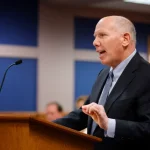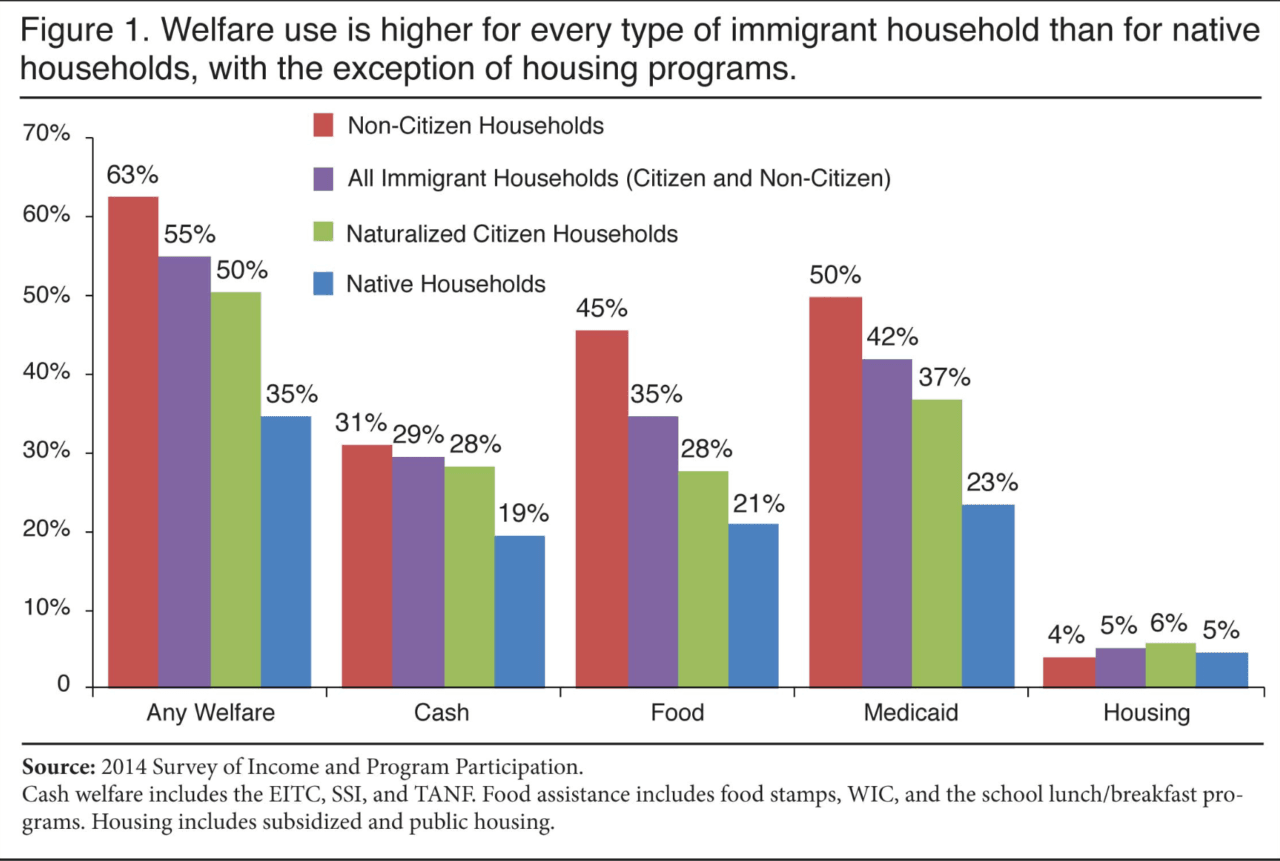President Trump’s administration on Monday started implementing the federal regulation geared toward stopping likely welfare-dependent legal immigrants from permanently resettling in the United States.
After the U.S. Supreme Court gave the green light for the regulation, the Trump administration has now begun applying what is known as the “Public Charge” rule — a rule whereby legal immigrants are less likely to secure a permanent residency in the U.S. if they have used any forms of welfare in the past, including any cash benefits for income maintenance, Supplemental Security Income (SSI), Temporary Assistance to Needy Families, Supplemental Nutrition Assistance Program (SNAP)– otherwise known as food stamps, Medicaid, and certain taxpayer-funded housing programs.
The rule will now apply nationwide and, as Breitbart News previously noted, will favor younger, self-sufficient, healthier, and English-speaking legal immigrants over those who have used at least one form of public welfare for more than 12 months within any 36-month period.
When last asked of their support for the rule, 56 percent of Hispanic Americans said they supported favoring self-sufficient legal immigrants for green cards over welfare-dependent legal immigrants, as well as about 6-in-10 of all American voters and 62 percent of all swing voters.
Acting Department of Homeland Security (DHS) Deputy Secretary Ken Cuccinelli said in a statement that the Public Charge rule is merely a continuation of “longstanding law” dating back to the 1800s. Most recently in 1996, a rule demanding legal immigrants be self-sufficient was codified into federal statute but has hardly ever been enforced. Cuccinelli said:
Trump and former Fulton County codefendants plan to hold Fani Willis to ‘maximum legal accountability’
Nude burglar arrested on Christmas night after allegedly breaking into two luxury Florida homes
Former Florida law enforcement officer accused of forcing 6-year-old underwater in hotel pool: report
California family revives beloved Christmas tradition with surprise sleepover visit
$220 Million Green Bay Packers Star Sparks Controversy After Christmas Gifting Revelation
Trump to Meet Zelenskyy at Mar-a-Lago ‘to Work Out Issues as Much as Possible’
MAHA Hits Roadblock After Obama Judge Sides with Conglomeration of Food Dye Corporations
Christmas Tragedy: Grandfather Dies After Gruesome ‘Freak Accident’ at McDonald’s
Trump reveals potential Kennedy Center marble armrests ‘unlike anything ever done or seen before’
Cowardly Scum: Man Kills Himself After Shooting His Family Over NFL Dispute
Tiny Pacific nation to take up to 75 deportees as Trump administration accelerates mass removals
Misspelled learning center, no children inside: Emmer presses Walz over Minnesota daycare tied to $4M
Trump suggests he’ll call final shots on peace deal ahead of Zelenskyy meeting: ‘We’ll see what he’s got’
Kash Patel announces permanent closure of J. Edgar Hoover FBI Building for Reagan building move
Interior Department plans AI Theodore Roosevelt exhibit for America250
This rule enforces longstanding law requiring aliens to be self-sufficient, reaffirming the American ideals of hard work, perseverance, and determination. It also offers clarity and expectations to aliens considering a life in the United States and will help protect our public benefits programs.
Foreign nationals arriving in the U.S. as refugees, asylees, victims of human trafficking, domestic violence victims, and violent crime victims are not subject to the Public Charge rule.
The big business lobby and corporate interests have denounced the rule because they say they need welfare-dependent legal immigrants coming to the U.S. to grow the economy, create more consumers, and secure a never-ending flow of lower-wage foreign workers.
Trump’s “Public Charge” immigration reform is bad economic policy b/c it will slow economic growth, says Forbes magazine.
Maybe, but it will also shift some income from investors to employees.
FWIW, I suspect most voters favor that economic trade-off. https://t.co/IPRz7GpTeu— Neil Munro (@NeilMunroDC) January 29, 2020
U.S. investors denounce Pres. Trump’s ‘Public Charge’ immigration reform — which will deny them extra consumers & workers, & will shrink taxpayers’ spending on medical & welfare programs used by poor & sick migrants.
Money explains much about migration.https://t.co/1vsGVWr7MI.— Neil Munro (@NeilMunroDC) January 21, 2020
Trump and former Fulton County codefendants plan to hold Fani Willis to ‘maximum legal accountability’
Nude burglar arrested on Christmas night after allegedly breaking into two luxury Florida homes
Former Florida law enforcement officer accused of forcing 6-year-old underwater in hotel pool: report
California family revives beloved Christmas tradition with surprise sleepover visit
$220 Million Green Bay Packers Star Sparks Controversy After Christmas Gifting Revelation
Trump to Meet Zelenskyy at Mar-a-Lago ‘to Work Out Issues as Much as Possible’
MAHA Hits Roadblock After Obama Judge Sides with Conglomeration of Food Dye Corporations
Christmas Tragedy: Grandfather Dies After Gruesome ‘Freak Accident’ at McDonald’s
Trump reveals potential Kennedy Center marble armrests ‘unlike anything ever done or seen before’
Cowardly Scum: Man Kills Himself After Shooting His Family Over NFL Dispute
Tiny Pacific nation to take up to 75 deportees as Trump administration accelerates mass removals
Misspelled learning center, no children inside: Emmer presses Walz over Minnesota daycare tied to $4M
Trump suggests he’ll call final shots on peace deal ahead of Zelenskyy meeting: ‘We’ll see what he’s got’
Kash Patel announces permanent closure of J. Edgar Hoover FBI Building for Reagan building move
Interior Department plans AI Theodore Roosevelt exhibit for America250
The rule is a boon for American taxpayers in the form of an annual $57.4 billion tax cut — the amount taxpayers spend every year on paying for the welfare, crime, and schooling costs of the country’s mass importation of 1.2 million new, mostly low-skilled legal immigrants.
In 2017, National Academies of Science noted that state and local American taxpayers are billed about $1,600 each year per immigrant to pay for their welfare and revealed that immigrant households consume 33 percent more cash welfare than American citizen households.
A similar Center for Immigration Studies (CIS) study found that about 63 percent of noncitizen households in the U.S. use at least one form of public welfare, while only about 35 percent of native-born American households are on welfare. This means that noncitizen households use nearly twice as much welfare as native-born American households.
In California — with the largest noncitizen population in the country at almost 11 million or nearly 30 percent of the state’s total population — more than seven-in-ten, or 72 percent, of noncitizen households are on at least one form of welfare. Compare that to the findings that only about seven-in-twenty, or 35 percent, of native-born households in California are on welfare.
Trump and former Fulton County codefendants plan to hold Fani Willis to ‘maximum legal accountability’
Nude burglar arrested on Christmas night after allegedly breaking into two luxury Florida homes
Former Florida law enforcement officer accused of forcing 6-year-old underwater in hotel pool: report
California family revives beloved Christmas tradition with surprise sleepover visit
$220 Million Green Bay Packers Star Sparks Controversy After Christmas Gifting Revelation
Trump to Meet Zelenskyy at Mar-a-Lago ‘to Work Out Issues as Much as Possible’
MAHA Hits Roadblock After Obama Judge Sides with Conglomeration of Food Dye Corporations
Christmas Tragedy: Grandfather Dies After Gruesome ‘Freak Accident’ at McDonald’s
Trump reveals potential Kennedy Center marble armrests ‘unlike anything ever done or seen before’
Cowardly Scum: Man Kills Himself After Shooting His Family Over NFL Dispute
Tiny Pacific nation to take up to 75 deportees as Trump administration accelerates mass removals
Misspelled learning center, no children inside: Emmer presses Walz over Minnesota daycare tied to $4M
Trump suggests he’ll call final shots on peace deal ahead of Zelenskyy meeting: ‘We’ll see what he’s got’
Kash Patel announces permanent closure of J. Edgar Hoover FBI Building for Reagan building move
Interior Department plans AI Theodore Roosevelt exhibit for America250
Currently, there is an estimated record high of 44.5 million foreign-born residents living in the U.S. This is nearly quadruple the immigrant population in 2000. The vast majority of those arriving in the country every year are low-skilled legal immigrants who compete against working and middle-class Americans for jobs.
Story cited here.

























